
This parent guide supports parents in helping their child at home with the 7th grade Science content.
- Subject:
- Science
- Material Type:
- Reference Material
- Vocabulary
- Author:
- Kelly Rawlston
- Letoria Lewis
- Date Added:
- 10/11/2022

This parent guide supports parents in helping their child at home with the 7th grade Science content.

This resource accompanies our Rethink 7th Grade Science course. It includes ideas for use, ways to support exceptional children, ways to extend learning, digital resources and tools, tips for supporting English Language Learners and students with visual and hearing impairments. There are also ideas for offline learning.

The AQ-IQ Contest for Seventh Grade Students has students creating a project on an air quality problem, looking for solutions to the problem, and creating a poster, on-line interactive, artist, or video project to educate others about the issue. Students will submit the projects and bibliographies using an on-line tool. The pest projects will be invited to a recognition ceremony and receive a prize package. Visit the AQ-IQ Landing Page for more information and resources: http://web.eenorthcarolina.org/resource/about.aspx?s=121764.0.0.37430

This resource is a lesson plan in which, using a bottle and a hard boiled egg, students will see that air exerts pressure. They will analyze evidence about particles of matter and demonstrate the role of motion in the particulate description of matter.
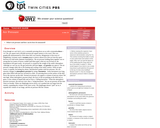
Students learn about air pressure and how changes in atmospheric pressure can relate to weather patterns. Students will demonstrate air pressure in an associated activity.

This is a hands-on project that uses George Orwell's novel, Animal Farm, as the touchstone text. Students work in groups to construct a functioning windmill that can generate electricity. Each student has a role based on the characters in the book. There are also segments of the project that focus on extracting key information from the text.
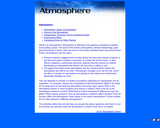
Students learn about the composition of the atmosphere and how atmospheric conditions affect humans.

Students will learn about the structure and composition of the atmosphere. Students will also track weather conditions for four days. and relate their observations to atmospheric characteristics.

This is a four-day unit focusing on the composition, properties, and structure of Earth's atmosphere. The lessons are embedded in a Google Slide presentation (http://bit.ly/AtmosphereCharacteristics) allowing teachers to modify the lessons to their needs. Formative and summative assessments are included in the form of warm-up and exit ticket questions and a summative project.

In this activity, students create a model using metric measuring tapes and atmosphere composition data. Students will investigate the major components of the atmosphere (nitrogen and oxygen) as well as the minor components which raise questions about global warming and greenhouse gases.

With this interactive resource, students can explore what would happen if the amounts of oxygen, carbon dioxide, and ozone were increased or decreased on Earth.

Within the earth science strand of 7th grade science, students focus on understanding the cycling of matter in and out of Earth’s atmosphere. In this task, students discover the stages that lead to Earth’s current atmosphere, investigate the cycles that maintain the Earth’s current atmosphere, and write a fictional account of one of the cycles from that gas molecule/compound’s point of view. The analytical reading and diagram interpretation, as well as the creative writing nature of this lesson allow students to build content understanding while promoting 21st Century Skills. This lesson was developed by NCDPI as part of the Academically and/or Intellectually Gifted Instructional Resources Project. This lesson plan has been vetted at the state level for standards alignment, AIG focus, and content accuracy.

This resource is an article that answers the question, "Why is the Earth the only known planet to have life?"

In this lesson, students will look at the different layers of the atmosphere to determine how the atmosphere helps sustain life on Earth. Students will model the layers of the atmosphere through an interactive lab that looks at characteristics of the atmosphere by analyzing the atmospheric temperature profile and the special features that can be found in each layer.
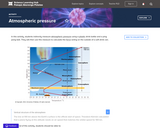
Students indirectly measure atmospheric pressure using a plastic drink bottle and a ping pong ball. They will then use this measure to calculate the force acting on the outside of a soft drink can.

Lab for students to understand the factors that influence atmospheric pressure.

Lab for students to understand the factors that influence atmospheric pressure.
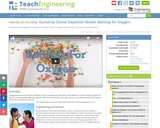
Using gumdrops and toothpicks, students conduct a large-group, interactive ozone depletion model. Students explore the dynamic and competing upper atmospheric roles of the protective ozone layer, the sun's UV radiation and harmful human-made CFCs (chlorofluorocarbons).
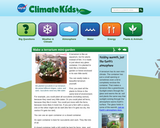
Instructions are provided for constructing a terrarium. The analogy between the terrarium and Earth is also provided. This activity is part of the Climate Kids website, a NASA education resource featuring articles, videos, images and games focused on the science of climate change.

In this lesson, students will explore convection using classroom experiments on Earth and then compare the results with the results of the same experiment in the microgravity environment onbaord the International Space Station.